By Patrick Begley and Carrie Fellner
In the mid-1980s, decorated police officer Roger Rogerson was reportedly meeting with the hardened criminal Neddy Smith at the Iron Duke Hotel.
Aiming for a picture of the pair together, police set up a camera on the roof of a nearby housing estate in Waterloo, using a lens so heavy it took two men to carry it.
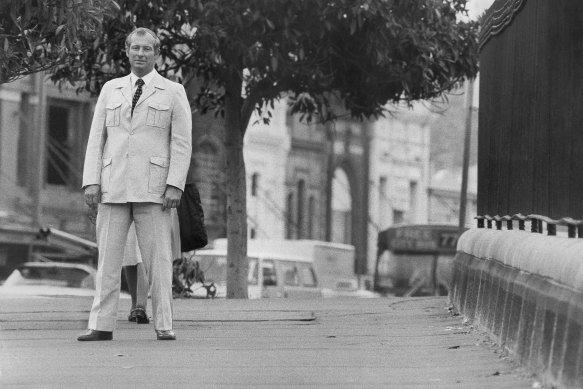
Roger Rogerson, a ‘brilliant cadet’, a ‘charming guy’ and a target for the Internal Police Security Unit in the 1980s.Credit: Sydney Morning Herald
Kimbal Cook was behind the camera. He had worked with Rogerson, “a brilliant cadet” and “charming guy”, in the Criminal Investigation Branch in the 1970s. Now he was working on Rogerson, as part of the Internal Police Security Unit in which cops investigated their own.
At one point the unit’s safe-house apartment in Ultimo was broken into and a pistol was stolen. Cook remembers “the only file that was taken was Roger Rogerson’s”.
Cook, 74, speaks of corruption with disgust. (He was once described by the Independent Commission Against Corruption as “stubbornly upright”.) He sees Rogerson not as a singular evil but as a product of his time, a time when crooked cops were often relied upon by superiors to get results, even if that meant “loading up” a weapon onto a suspect for a quick arrest. “He wasn’t born bad,” Cook says. “It was the system that made him bad.”
That system has been the subject of a royal commission and numerous reform programs in the decades since, as NSW Police and state governments try to ensure that another “Dodger” can never rise.

Detective Sergeant Kimbal Cook leaving the ICAC in 1994 after giving evidence. The commission found he was “stubbornly upright”.Credit: Steven Siewert
At the same time Rogerson was ascending through the force, corruption reached some of the highest echelons of NSW power. Robert Askin, the state’s premier in the 60s and 70s, had unexplained wealth. Rex Jackson, the minister for prisons, ended up in one for conspiring to accept bribes in the early 80s.
Within the police, officers far more senior than Rogerson would face accusations of corruption and misconduct, including a string of three commissioners in the 1970s.
In 1982, deputy commissioner Bill Allen was forced to resign after taking an overseas holiday partly paid for by gambling figures and regularly meeting with the state’s most notorious gangster, Abe Saffron.
Peter Anderson, the Wran-era police minister who weathered the Allen affair, says he was fortunate that the men who served as head of police in his time were all beyond reproach. “That was a luxury,” he says.
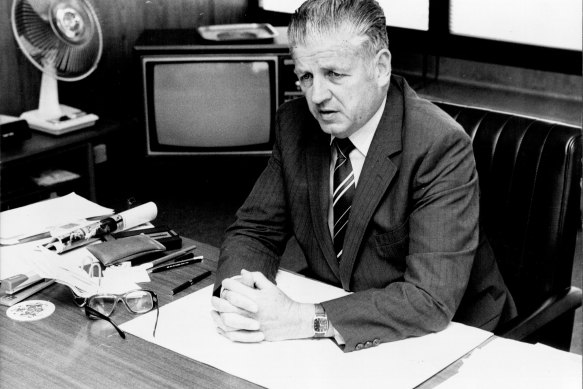
Deputy police commissioner Bill Allen saw Abe Saffron alone in his office six times.Credit: Fairfax Media
But Anderson says efforts to curb Rogerson were thwarted by a lack of evidence and the detective’s hero reputation, enhanced by parts of the media. When Rogerson was accused of bribing undercover officer Mick Drury, a jury found him not guilty.
“If you’re told this bloke was the greatest copper of all time, it’s got to have an influence on a jury,” Anderson, who served as minister from 1981 to 1986, says.
The Labor government introduced a reform package that created the Internal Police Security Unit and expanded the Ombudsman’s powers to investigate complaints against police.
But a decade-long attempt to cleanse the force of corruption had barely made a ripple in Kings Cross, says Shari Allison, who arrived at the Cross as a fresh-faced cadet in 1989 to find a cabal of corrupt cops ruling the streets.
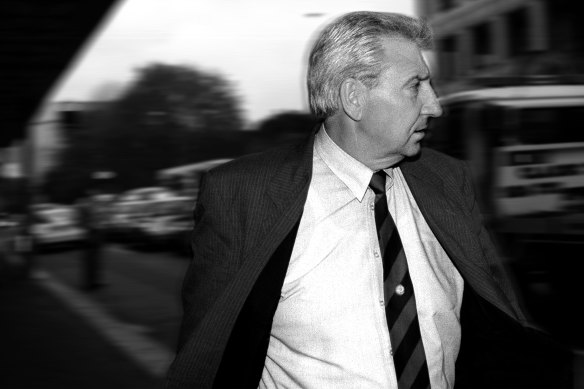
Notorious former Kings Cross detective Graham ‘Chook’ Fowler, who was caught on camera taking a bribe.Credit: Fairfax Media
They included notorious detectives Graham “Chook” Fowler and Trevor Haken, both later exposed by the Wood Royal Commission into police corruption.
More than a dozen outlets in Kings Cross were allowed to sell drugs without police incursion, while other dealers were shut down or planted with evidence if they did not play ball.
“I remember being exposed to some shocking behaviour by the police that I worked with,” Allison says, recalling officers dragging criminals into rooms at the station where they would be bashed.
It didn’t sit well with Allison, who was mostly ignored by those in the clique. “They didn’t want to bring you into their own little circle of corruption,” she says.
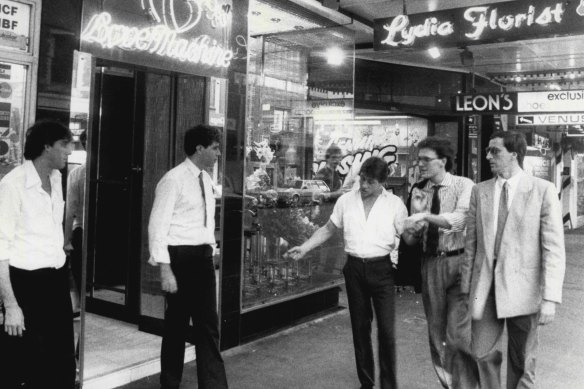
Corruption controlled the policing of Kings Cross in the 1980s.Credit: Fairfax Media
It was nothing like the picture then-commissioner Tony Lauer described in a 1991 interview with Four Corners. Lauer told journalist Neil Mercer that his predecessor had won the war on corruption, even if isolated instances of bad behaviour still occurred. “I am quite certain there is no institutionalised corruption in NSW,” he said.
Mercer was dubious. “I remember saying to his offsider or press secretary … Jesus mate, that’s a bit bold,” he says this week. “As it transpired, it wasn’t [right] by a long shot.”
At the time, independent MP John Hatton, a lonely crusader for a royal commission into police corruption, had just seized the balance of power in the NSW parliament.
Hatton first sensed something was amiss witnessing the way the mafia were operating with impunity in Griffith and how the unsolved murder of Kings Cross identity Juanita Nielsen was handled by police. He began to speak publicly about drug trafficking and organised crime across NSW. “The amount of information that came to me was extraordinary,” Hatton recalls.
He was given evidence that implicated Rogerson in the 1981 murder of Warren Lanfranchi and met with drug addicts who said they were “total captives of police”.
Hatton said the internal affairs branch, supposed to look after the integrity of the force, was utterly ineffective. Even the promotions system had been commandeered by corrupt forces, he found. An ambitious officer could fast-track their way up the hierarchy by demonstrating a willingness to bend moral codes.
“Honest police, and I met with them on a regular basis mainly in Balmain, were not only persecuted but terribly afraid of even being killed.”
By now, Hatton was under immense pressure, with death threats forcing him to go into hiding in a safe house in sleepy Sussex Inlet. “My late wife, she’s the hero of this story. Not once did she ask me not to do what I was doing,” he says.
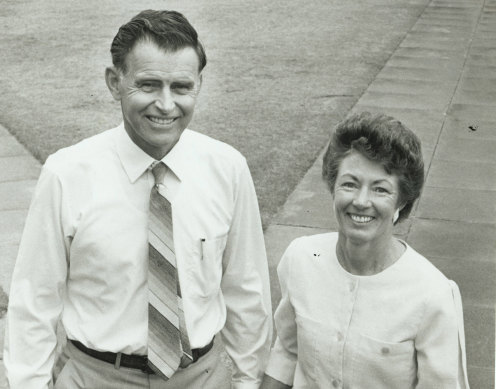
John Hatton said his wife Vera never asked him to halt his pursuit of corrupt police.
Eventually, a breakthrough came after Hatton delivered a speech about police corruption in May 1994. Then-opposition leader Bob Carr used Labor’s numbers against the government to support the establishment of a royal commission.
Running for three years, the Wood Royal Commission concluded in 1997 that police corruption was “entrenched and systemic”. It swept a broom through the force, with a total of 284 police officers adversely named.
Seven officers received jail sentences, including the former Gosford drug squad chief Wayne Eade and Graham “Chook” Fowler.
The Carr government response included the introduction of drug and alcohol testing, “integrity testing” to check officers’ responses to graft opportunities, and a new power allowing the police commissioner to fire officers suspected of wrongdoing.
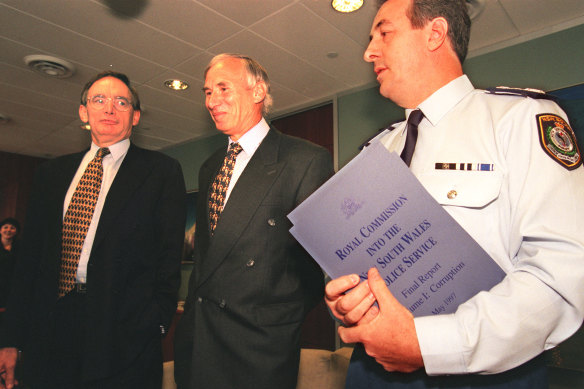
Justice James Wood (centre) hands over his royal commission report into NSW Police to premier Bob Carr in 1997. Police commissioner Peter Ryan holds the report.Credit: Fairfax
One of the biggest shifts came in the form of a new Police Integrity Commission, which was independent, unlike the old Internal Police Security Unit. “We went from having a corruption-prone to a corruption-resistant police force,” Carr says.
The practice of recording interviews made it harder for police to “verbal” criminals with false confessions.
But perhaps the biggest change, says John Agius, SC, who served as counsel assisting the royal commission, was to remove the idea that police were required to secure convictions.
“That was one of the things that drove the corruption,” he says. “If people didn’t have the evidence, very often police invented it, and we exposed that.”
Could another Rogerson emerge today? “Absolutely not,” Agius says, pointing to increased oversight through technology and changes in culture.
Recent annual reports by the Law Enforcement Conduct Commission, the latest police integrity body, show a number of investigations into allegations of bribery, misuse of authority and the protection of people involved in criminal activity.
In a statement, a commission spokesperson said that while the risk of corruption was “always present”, the recruitment, training and management of officers was “remarkably different” since the Wood Royal Commission.
The commission “has legislation and technical capabilities available to it that were not available in the 1970s and 1980s”.
A NSW police spokesperson said in a statement: “NSW Police Force officers are subject to rigorous oversight and the organisation is continually looking to improve its processes to ensure we meet the highest of standards.”
Allison, who left Kings Cross and later became a chief inspector with the Professional Standards Command, says Rogerson wouldn’t survive into today’s policing environment: “He got caught out in the end, he wasn’t as smart as he thought he was.”
Allison says the force has welcomed a large influx of junior officers who hold different attitudes towards whistleblowing. “They’re willing, for want of a better word, to dob their mates in if they’ve done the wrong thing, whereas previously … you’d be considered a dog and your life would be miserable.”
But Hatton is circumspect, arguing that whenever the interests of police, politicians, property developers and influential business people coincide, there is opportunity for organised crime to flourish.
He says there will never be a way to stop corruption, but a royal commission into the force once a decade would be a way to bring it down to reasonable levels. “That then means there’s a final judgment day they can’t avoid,” he says. “I think there has to be eternal vigilance.”
Cook, the former surveillance officer, left the force to become a salesman after blowing the whistle on a bribery attempt by fellow officers in the late 80s.
He faced a campaign of bullying, assaults and threats, described by the Wood Royal Commission as “a classic example of the poor treatment of internal informers”. His advice to young officers: “Don’t sell your soul.”
Start the day with a summary of the day’s most important and interesting stories, analysis and insights. Sign up for our Morning Edition newsletter.